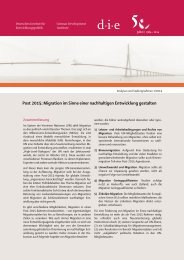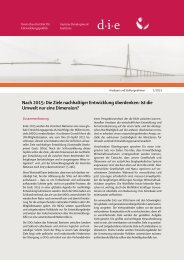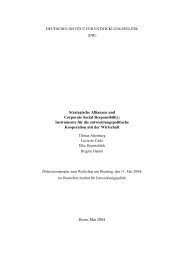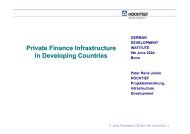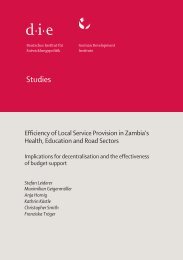Middle East / North Africa and the Millennium Development Goals ...
Middle East / North Africa and the Millennium Development Goals ...
Middle East / North Africa and the Millennium Development Goals ...
You also want an ePaper? Increase the reach of your titles
YUMPU automatically turns print PDFs into web optimized ePapers that Google loves.
<strong>Middle</strong> <strong>East</strong> / <strong>North</strong> <strong>Africa</strong> <strong>and</strong> <strong>the</strong> <strong>Millennium</strong> <strong>Development</strong> <strong>Goals</strong><br />
is able but not willing to solve <strong>the</strong> problems facing its population. In this<br />
case DC will not be able to accomplish much, because it depends – as <strong>the</strong><br />
term indicates – on <strong>the</strong> existence of a partner which perceives <strong>the</strong> problems<br />
at h<strong>and</strong>, shows interest in tackling <strong>the</strong>m, <strong>and</strong> is willing to contribute<br />
whatever it can to solving <strong>the</strong>m.<br />
In o<strong>the</strong>r words, <strong>the</strong> optimal conditions are given when a developing country<br />
is faced with a very high urgency of problem-solution, when its government<br />
is highly disposed to tackle <strong>the</strong>se problems, <strong>and</strong> when at <strong>the</strong> same<br />
time its capacity to solve existing problems is markedly low. A model like<br />
<strong>the</strong> one presented in Overview 6 might be used to review <strong>the</strong> extent to<br />
which such conditions are given in any of <strong>the</strong> partner countries of German<br />
DC. The overview presents a hypo<strong>the</strong>tical case, which does not resemble<br />
any real country. As a consequence, <strong>the</strong> goal orientation subscribed to <strong>the</strong><br />
German DC at present is also entirely hypo<strong>the</strong>tical. The third to seventh<br />
column reflect <strong>the</strong> partner country’s urgency, capacity, <strong>and</strong> disposition to<br />
solve its problems. The last column, finally, makes proposals for a reorientation<br />
of German DC with <strong>the</strong> model partner country.<br />
In looking at <strong>the</strong> urgency <strong>and</strong> capacity to solve given problems, we have to<br />
distinguish here between two different aspects. We can speak of a high urgency<br />
to take measures against a problem if <strong>the</strong> country’s absolute MDG indicator<br />
values are especially low (if e.g. a large proportion of <strong>the</strong> population is<br />
suffering from hunger). Against <strong>the</strong> background of <strong>the</strong> MDGs, however, we<br />
can also speak of a high urgency to solve a problem if – regardless of initial<br />
levels – <strong>the</strong> relative change in a country’s indicator values is unsatisfactory (if<br />
e.g. its child mortality rate has not improved much over <strong>the</strong> past years).<br />
The capacity of a country to solve its own problems, on <strong>the</strong> o<strong>the</strong>r h<strong>and</strong>, depends<br />
on (i) <strong>the</strong> capacities <strong>and</strong> possibilities of its institutions, but also (ii) <strong>the</strong><br />
capacities <strong>and</strong> possibilities that have been opened to <strong>the</strong> country through its<br />
DC with <strong>the</strong> donors. The point of factoring in this last aspect is to prevent<br />
German DC from becoming active in countries or sectors where many o<strong>the</strong>r<br />
donor countries are already providing support while at <strong>the</strong> same time overlooking<br />
countries <strong>and</strong> sectors that are neglected by all o<strong>the</strong>r donors as well.<br />
German <strong>Development</strong> Institute 121



